Padma Shree Artist’s Terracotta Marvels Have Global Fans, Command Prices in Lakhs
V K Munusamy has single-handedly trained 800 families in his region to make terracotta items and taught thousands of students for free to keep alive what he loves the most.
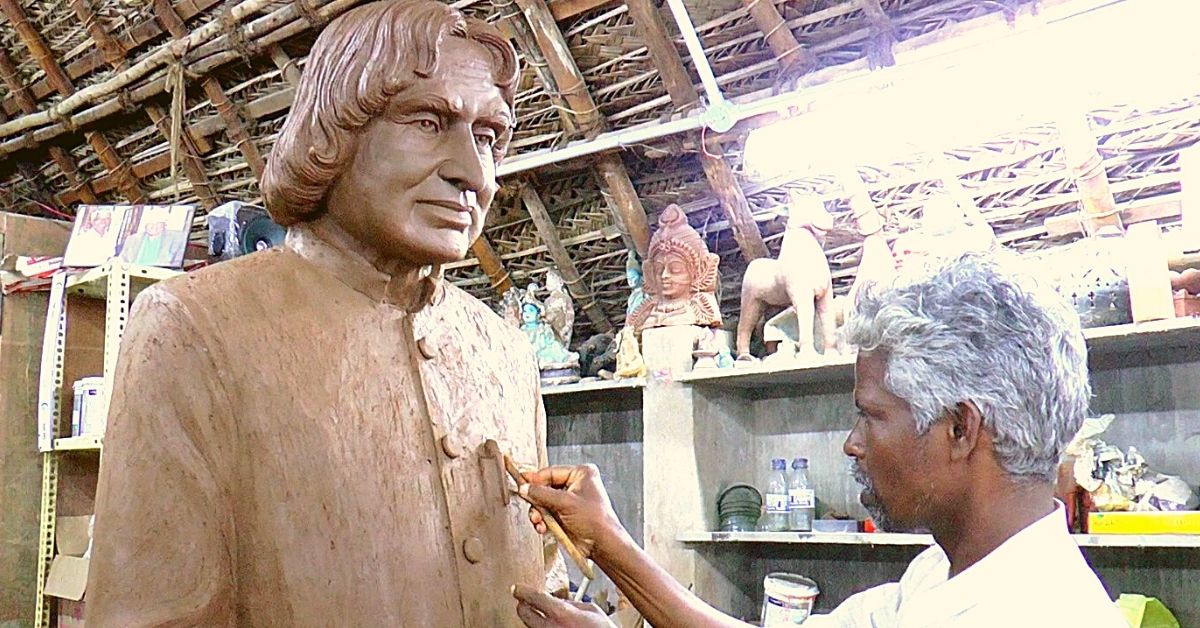
The entrance to artist V K Munusamy’s house in Villianur, about seven kilometres from Puducherry city, looks like a scene straight out of an art film. And rightly so. After all, the Padma Shree awardee is known for making dramatic life-size terracotta statues and miniatures as small as 1.5 inches for over 40 years.
As you walk further inside, the earthy fragrance from scattered terracotta pieces welcomes you.
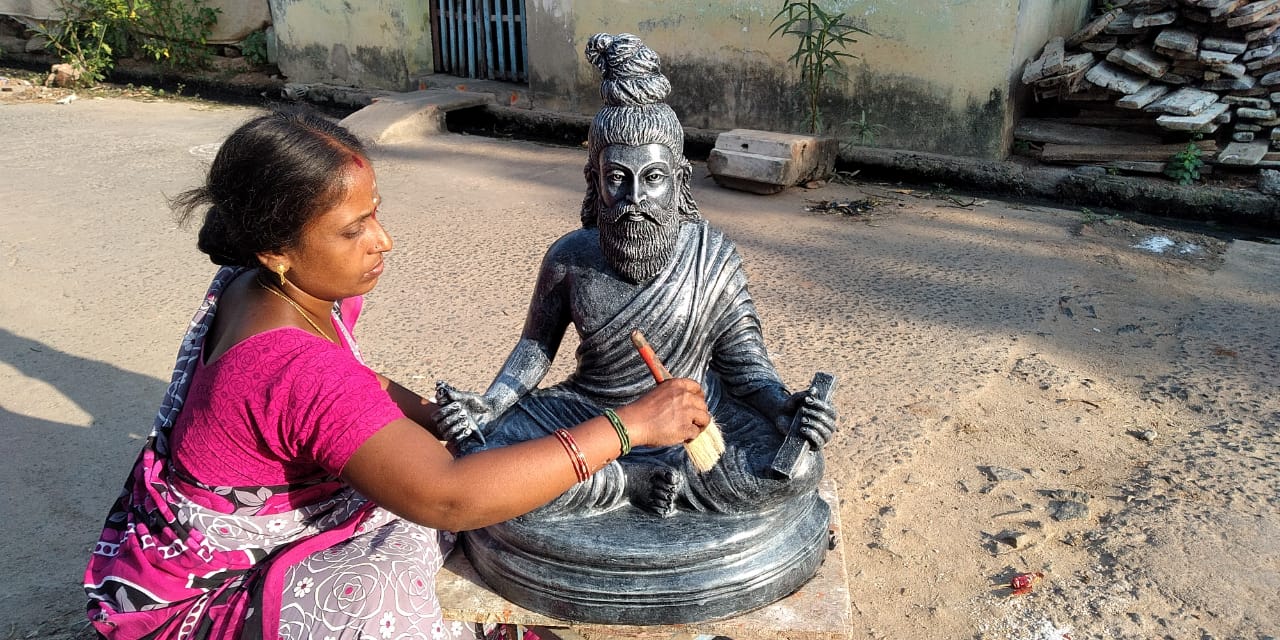
A couple of women artists are swiftly carving intricate patterns on what will be either a horse, a likeness of the Buddha, a toy, an elephant or a human-sized deity. Their eyes are pinned to the fast drying riverside clay, with a complete focus on the patterns. But they also chat about their day and some even help their children do their school homework.
A little further away, Munusamy is crouching on the ground and working on a pottery wheel to make Ganapati idols, to meet orders from Karnataka. Though he is near the kilns, the heat does not appear to bother him. His skilled hands effortlessly shape cones of clay within minutes.
Mastering the craft over decades, the 53-year-old’s terracotta pieces come in all sizes. The price can range from as cheap as Rs 50 paise to Rs 4 Lakh, depending on the piece.
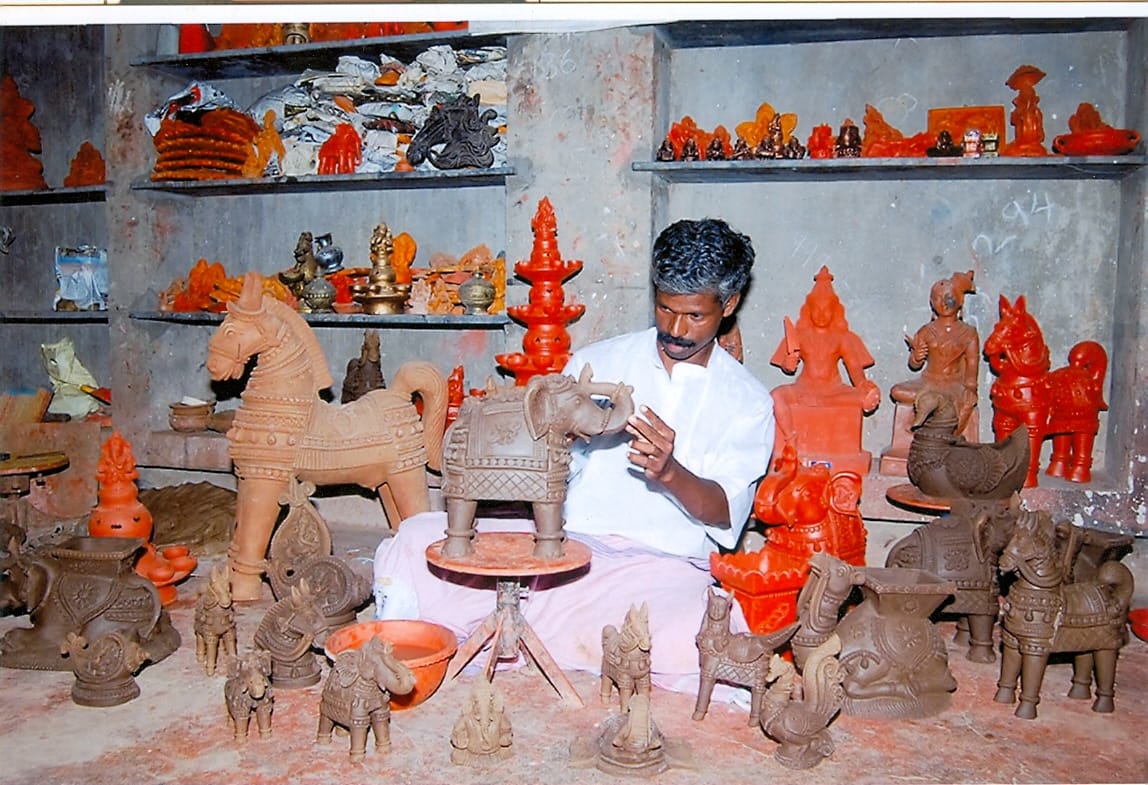
Munusamy is a 21st generation terracotta artist, who has earned global fame, six national awards, multiple state awards and an unofficial responsibility of preserving a dying art form.
Unlike many artists who have discontinued terracotta production due to alternatives like sandstone or marble, Munusamy has willfully taken the hereditary charge to take forward his family’s legacy. His son, who is currently doing his undergraduate from Chitrakala Parishath in Bengaluru, will be a millennial entrant to the artform.
Born to parents Krishan Pathar and Mangalaxmi in 1967, Munusamy was exposed to terracotta structures when he turned five.
“As a kid, I would hurriedly crawl towards the clay and imitate my father’s actions. Sometimes, when they took away clay, I would take paper and make small balls. Though a generational occupation, the craft did not come easy, I had to earn it. My father allowed me to use clay only after I had perfected the task of giving shapes to the dough. He was an earnest artist who treated his art with the utmost respect. I have inherited all the values and skills from him and I hope to pass it down to our future generations,” Munusamy, who bagged India fourth highest civilian award this year, tells The Better India.
A Sustainable Process Dipped In Ancient India
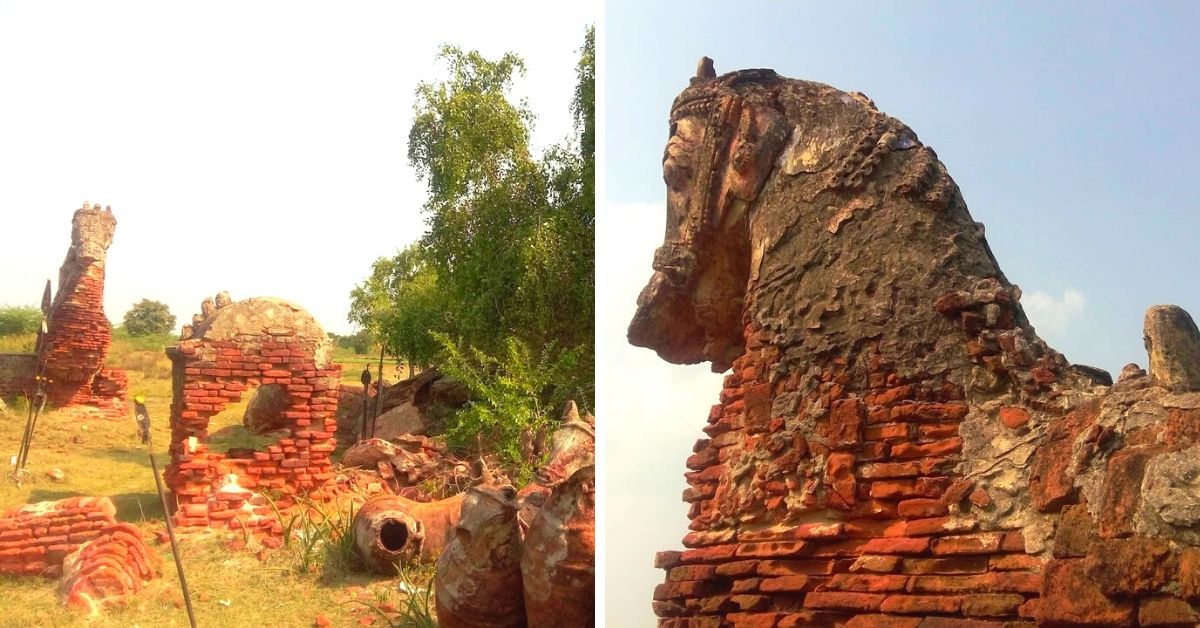
Generally, brown, grey, orange or red terracotta is made from clay sourced from the beds of water bodies. Once carved, this clay is dried and then fired under temperatures of around 1000°C. The final terracotta product is allowed to cool down slowly by covering it in the sand.
Munusamy is extremely particular about choosing soil for the final product’s sturdiness and quality.
He has tied up with landowners living close to riverfronts to purchase soil which he transports to his house on a bullock cart. Transporting soil on a modern vehicle is against the law, so this ancient form of transportation comes handy.
Next, tonnes of soil are laid in sunlight for the drying process. Once the water is removed, the weight reduces by 50 per cent. Next, he mixes the soil with paddy straw, wood sawdust and animal dung for thickness, and to prevent any damage in the firing process.
The mixture is carved into an artefact and kept untouched for a week. After which it goes in kilns for a few hours – depending on the size. A statue, for example, takes eight hours. After it is cooled down, the parts are coloured and painted.

With one life-sized figure using two tonnes of clay, the entire process lasts anywhere between 12 hours to a month. Anatomy and nuance in every artefact is Munusamy’s USP.
From bringing alive the late President APJ Abdul Kalam through an 8-foot statue to miniature idols, Munusamy may have lost the count of how many artefacts he has made, but he surely remembers the BTS of every project.
He had a strong emotional connection with the former President. In 2014, Munusamy had made terracotta structures to raise funds of Uttarakhand floods in Dili Hat. Moved by the gesture and the breathtaking pieces, the President Kalam spoke to Munusamy for an hour.

“He wanted to know everything about terracotta and how I was populating it from a small village of Tamil Nadu. The short conversation will be forever etched in my memory so when he passed away making his statue was the best way to pay him tribute,” he shares.
A Thriving Legacy
“Terracotta earthenware, equestrian figurines, and decorative items date back to the pre-Harappan civilisation. Archaeological excavations frequently unearth pots and vessels made from terracotta. Its rich history is vast and differs from region to region. Like for example, in Tamil Nadu, giant horses and elephants are made to guard temple entrances. Meanwhile, Alwar in Rajasthan is known for its paper-thin pottery (kagzi) and artisans in Bhuj make colourful clay pots with geometrical patterns. Haryana is known for its terracotta hookah and pipes,” says Munusamy.
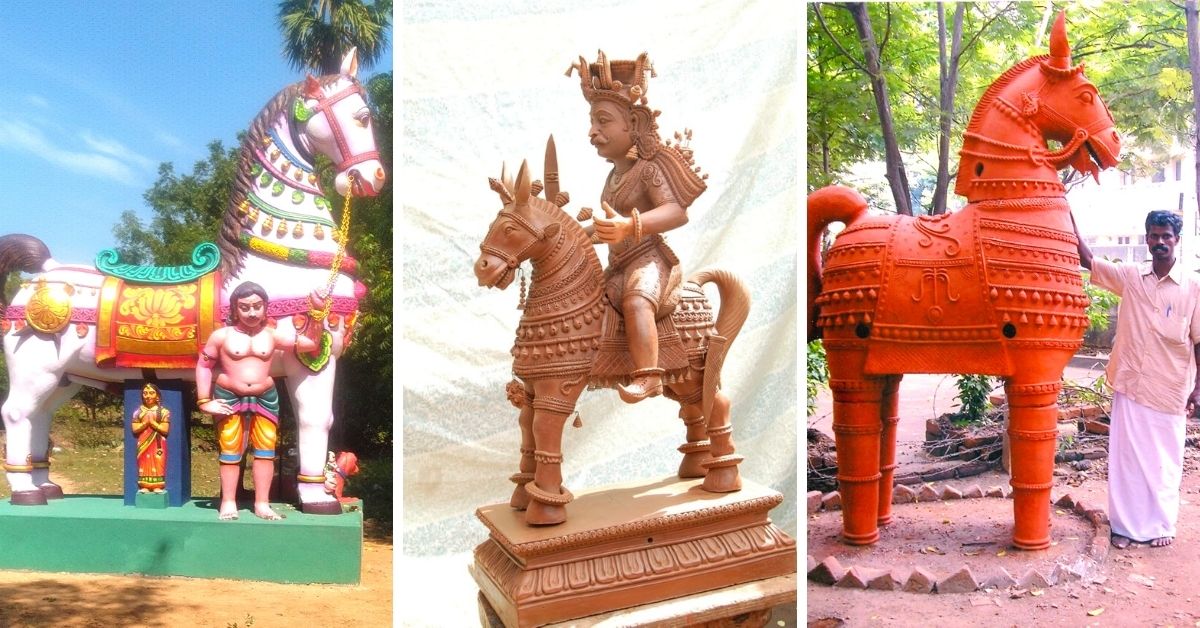
In Munusamy’s hamlet and most rural parts of Tamil Nadu, different deities and horses are made from terracotta.
Munusamy found his calling very early on but he was always keen on completing his education. However, due to financial restraints in the family, he dropped out in class eight and joined his father to meet the demand.
Since then, Munusamy has been in the profession and every day is an opportunity to improve his skills.
Although the family was already known for making tall deities, especially during Pongal (Tamil New Year), the family struggled financially. For the longest time, his father refused to venture into other products as he believed his work to be sacred and reserved only for deities.
After much convincing, Munusamy started making other items like vessels, toys, figurines, and miniatures to ensure a stable income during the 90s. He adapted to demands quickly. This was mainly done to increase the value of terracotta.
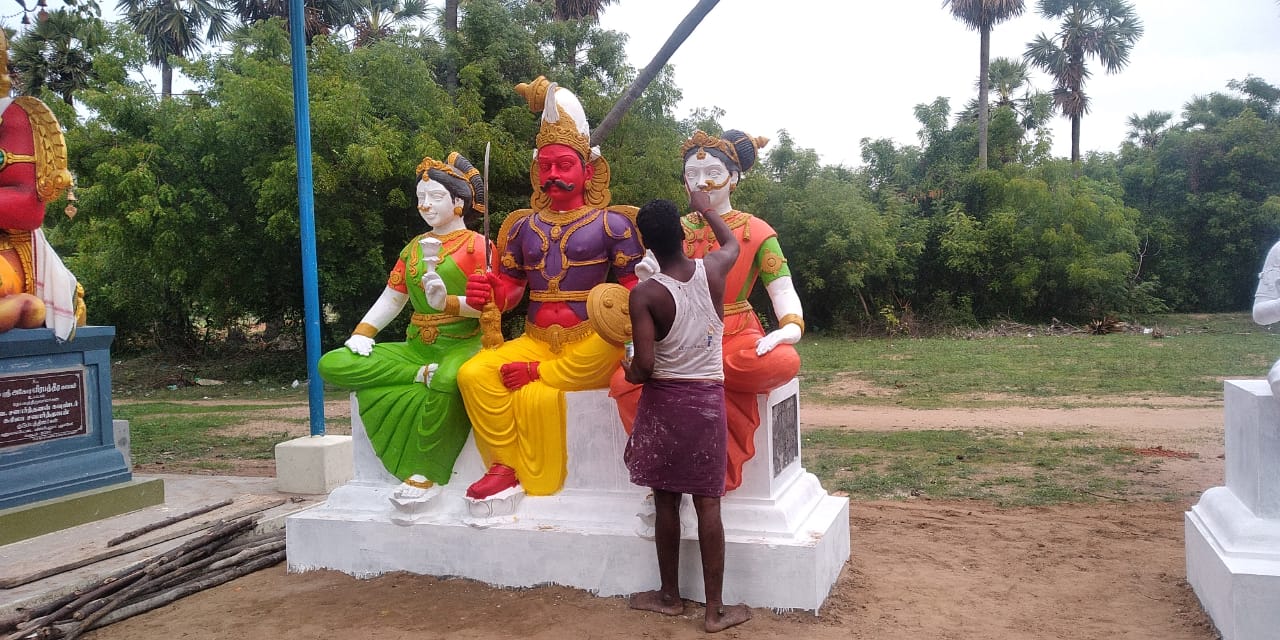
Every artisan, he says, sources pure clay from the riverside and hand-makes every item after going through a tedious process. However, visitors and vendors from outside the region are quick to dismiss the art as just another mitti installation.
“Disregard for man’s hard work and skills is the highest form of humiliation in every profession. I took the commercial route to educate people about our sincere efforts,” he says.
When our economy opened up to the outside world, the country witnessed an influx of more accessible materials like marble, copper and other stones. Artisans switched sides and some walked out on this disappearing art.
But not Munusamy. He had a legacy to continue.
Times were tough and the wrath of inflation knocked on his door multiple times. There were days when he had to take a loan for his raw materials and to pay the salary of his staff.
To make things better, he collaborated with the local government in the late 90s to promote his art. Munusamy attended his first international Exhibition in Barcelona, Spain in 2004.
There has been no looking back since.
He has visited 12 countries and attended several exhibitions and workshops to display his colourful artefacts.
Besides exhibitions, Munusamy also imparts terracotta training.
“Munusamy actively takes training sessions in educational institutions and government-organised events. He is a very committed artist who has worked exceptionally hard to spread awareness. Our office has helped him take part in several international exhibitions,” an official from District Industries Centre, Puducherry tells The Better India.

He also whole-heartedly welcomes foreigners and locals at his house to impart knowledge and skills. He has single handedly trained 800 families in his region to make terracotta items.
The value for his artwork is also reflected in the way he treats the staff members. They are like a part of his extended family. Under his regime, artists are paid as per their skills.
“Unlike stone carving, terracotta is not a one-time work. It takes hours to get the right patterns. Plus, the artefacts have a royal value. In future, my terracotta products may be considered antiques and priced at exorbitant rates. Thus, every artist deserves a hefty pay. Moulding can fetch Rs 15,000 per hour and basic patterns get Rs 1000 per hour.”
When asked what is the one goal he hopes to achieve before dying, Munusamy says, “I want to make a masterpiece when I turn 100, just like my parents.”
Munusamy’s honesty, devotion and sincerity towards his craft that he has honed for four decades is laudable and will be remembered for generations to come.
(Edited by Vinayak Hegde)
If you found our stories insightful, informative, or even just enjoyable, we invite you to consider making a voluntary payment to support the work we do at The Better India. Your contribution helps us continue producing quality content that educates, inspires, and drives positive change.
Choose one of the payment options below for your contribution-
By paying for the stories you value, you directly contribute to sustaining our efforts focused on making a difference in the world. Together, let’s ensure that impactful stories continue to be told and shared, enriching lives and communities alike.
Thank you for your support. Here are some frequently asked questions you might find helpful to know why you are contributing?


This story made me
-
97
-
121
-
89
-
167











